Spike stories are short, focused tasks aimed at uncovering information or exploring solutions to a tricky problem that complicates the sprint.
To understand what is a Spike in Agile, please picture this: you’re cruising along on your Agile project, everything’s flowing smoothly, and suddenly you hit a roadblock. That’s where spike stories arise to save the day.
When you encounter something in the project that’s a bit of a head-scratcher, instead of diving headfirst into the unknown and potentially wasting precious time, you throw in a spike story. It’s your chance to research, experiment, or prototype your way to enlightenment.
Spike stories in Agile aren’t typical user stories with clear objectives and acceptance criteria. They’re more like open-ended scripts where you’re free to search and find out. Once you’ve cracked the code and gathered your findings, you can use that newfound knowledge to inform your next steps.
Introduction to Spike Stories in Agile
Definition and Purpose of Spike Stories
Spike stories are like the secret agents of Agile software development. When you stumble upon a thorny problem or a murky area in the project, you send in a spike story to gather intelligence and pave the way for smoother progress.
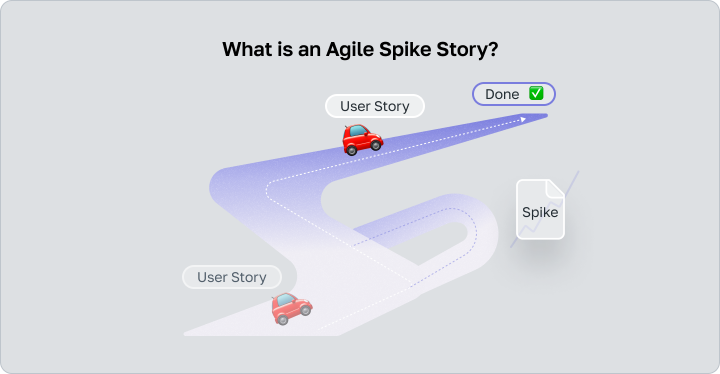
So, what exactly are they? To discover what is a spike user story, think of spike stories as short, time-boxed tasks aimed at exploration and investigation. They’re not typical user stories with well-defined requirements and outcomes. Instead, they’re more like expeditions into the unknown, where you roll up your sleeves and get your hands dirty digging for answers.
Here’s how they roll: when you encounter a roadblock, instead of blindly plowing forward or getting stuck in analysis paralysis, you create a spike story. This allows your Agile team to allocate a fixed amount of time to research, prototype, or experiment with potential solutions.
The beauty of spike stories lies in their flexibility and focus. They give you the freedom to dive deep into a problem without committing to a specific solution right off the bat. Plus, they help manage risk by uncovering potential pitfalls early on, saving you from costly detours down the road.
Now, let’s talk about their role in Agile, in particular Agile software development. Spike in Agile serve as a tool for managing uncertainty and reducing risk in your project. By investing a small amount of time upfront to gather information and explore possible solutions, you’re better equipped to make informed decisions and adapt your approach as needed.
Spike in Agile software development also promote a culture of learning and experimentation within your team. Instead of viewing obstacles as roadblocks, spike stories encourage you to embrace them as opportunities for growth and discovery.
In a nutshell, spike stories are the Agile team’s secret weapon for tackling the unknown, managing risk, and fostering innovation.
Historical Context and Evolution in Agile Methodology
Let’s explore the historical context and evolution of spike in Agile methodology, including how spike stories have found their place in Agile software development practices.
It all started in the early 2000s when a group of software developers got together in Snowbird, Utah, and crafted the Agile Manifesto. This manifesto outlined a set of values and principles for software development that emphasized flexibility, collaboration, and customer satisfaction over rigid processes and documentation.
Initially, Agile methodologies like Scrum and Extreme Programming (XP) focused on delivering working software in short, iterative cycles called sprints or iterations. User stories became the primary way of capturing requirements and driving development forward.
As Agile gained traction, teams began encountering situations where they needed to explore unknowns or conduct research before diving into implementation. Enter the concept of spike stories. While not explicitly mentioned in the original Agile Manifesto, spike in software development evolved organically as teams sought ways to address uncertainty and manage risk within the Agile framework.
Spike stories started appearing in Agile software development practices as a means of allocating time for research, experimentation, or prototyping when faced with unfamiliar territory or complex problems. They provided teams with a structured approach to investigate potential solutions without committing to a specific course of action upfront.
Over time, spike stories became an essential tool in the Agile toolkit, helping teams navigate uncertainties and make informed decisions while maintaining the iterative and adaptive nature of Agile development.
In essence, the evolution of spike in Agile practices reflects the ongoing refinement and adaptation of Agile methodologies to meet the ever-changing needs and challenges of software development. They represent Agile’s commitment to continuous improvement and its ability to embrace new techniques and practices as they emerge.
Understanding Spike Stories
The Role of Spike Stories in Agile Projects
Let’s delve into the spike story meaning in Agile projects. At the heart of Agile lies the principle of delivering value to the customer through iterative development and continuous improvement. Spike in Agile plays a crucial role in upholding this principle by providing teams with a structured mechanism to address uncertainties, manage risks, and gather essential information to drive the project forward.
First and foremost, spike stories serve as a vehicle for exploration and investigation. When teams encounter unfamiliar territory or complex problems during development, spike stories allow them to allocate dedicated time for research, experimentation, or prototyping. This exploration phase enables teams to gain a deeper understanding of the issue domain, explore potential solutions, and identify risks and dependencies early on.
Moreover, spike stories facilitate informed decision-making within Agile projects. By investing a fixed amount of time in investigating a specific aspect of the project, teams can gather valuable insights and data to guide their next steps. Whether it’s evaluating the feasibility of a new technology, researching alternative approaches, or validating assumptions, spike stories empower teams to make informed choices that align with project goals and customer needs.
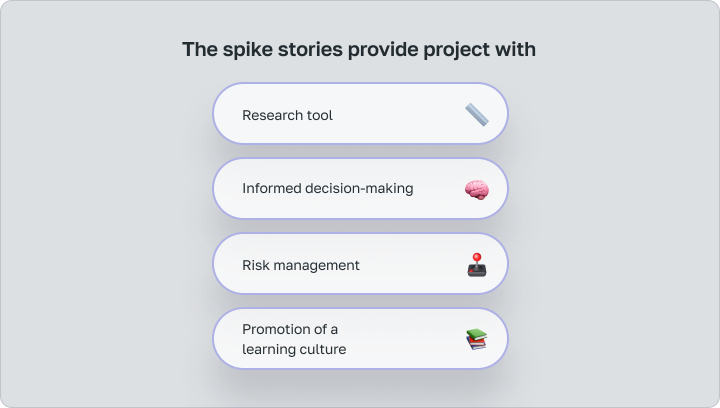
Furthermore, spike in Agile helps manage risk by uncovering potential roadblocks or challenges before they escalate. By proactively addressing uncertainties and unknowns through targeted research and experimentation, teams can mitigate risks and minimize the likelihood of costly setbacks later in the project lifecycle. This risk management aspect is particularly crucial in Agile projects, where the ability to adapt and respond to change is paramount.
Additionally, spike stories foster a culture of learning and innovation within Agile teams. By encouraging curiosity, experimentation, and collaboration, spike stories in Agile software development provide opportunities for team members to expand their knowledge, explore new ideas, and discover innovative solutions to complex problems. This culture of continuous learning and improvement, not only enhances individual and team performance but also drives long-term success and sustainability in Agile projects.
In summary, spike in Agile projects plays a multifaceted role, serving as a means of exploration, decision-making, risk management, and fostering a culture of learning and innovation. By providing teams with a structured approach to address uncertainties and gather essential information, spike stories enable Agile teams to deliver value to customers effectively and adapt to changing requirements and circumstances throughout the project lifecycle.
Differentiating Spike Stories from Regular User Stories
To understand the role of spike in Agile clearly, we need first to clear up the distinction between spike stories and standard user stories in Agile.
User stories are the bread and butter of Agile development. They’re concise, user-focused descriptions of desired functionality, typically written from the perspective of an end user or customer. User stories follow a simple template: “As a user, I want feature so that benefit.” They are used to capturing requirements, drive development, and ensure that the delivered product meets the needs of its intended users.
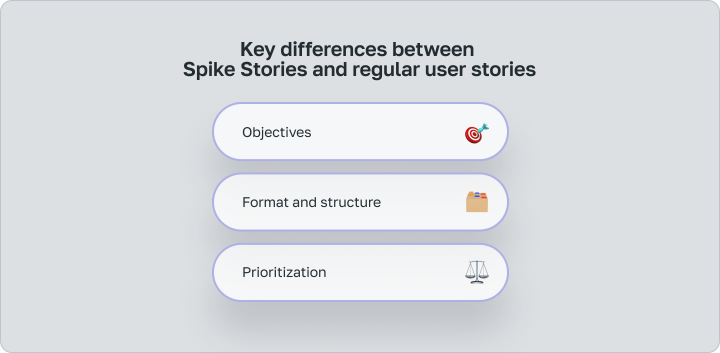
On the other hand, spike stories are a different beast altogether. While they share some similarities with user stories, such as being short and focused, spike stories serve a distinct purpose within Agile projects.
The first key difference lies in objectives
User stories are aimed at delivering tangible value to the customer by specifying desired functionality. They typically have clear acceptance criteria and drive development forward by providing a roadmap for implementation. In contrast, spike stories are not about delivering functionality, but they’re about exploration, investigation, and learning.
When a team encounters uncertainty, complexity, or technical challenges that require further investigation before proceeding with implementation, that’s where spike stories come into play. Spike in scrum provides a structured mechanism for teams to allocate time to research, experiment, or prototype potential solutions. They’re like mini-quests aimed at uncovering essential information, evaluating options, and reducing risk.
Second key difference is in their format and structure
User stories follow a standardized template and are typically written in a consistent format to ensure clarity and consistency. Spike stories, on the other hand, are more flexible and open-ended. They may not have well-defined acceptance criteria or a clear definition of “done” since their purpose is to explore and gather information rather than deliver a specific outcome.
Third difference is in the prioritization
User stories are typically prioritized based on their perceived value to the customer, while spike stories are prioritized based on the level of uncertainty or risk they address. Spike stories often precede the implementation of related user stories, providing teams with the insights and knowledge needed to make informed decisions and mitigate risks effectively.
In summary, while both user stories and spike stories are essential components of Agile development, they serve distinct purposes and differ in their objectives, format, and prioritization. User stories drive the delivery of value to customers, while spike in Agile facilitates exploration, investigation, and risk management within projects.
Writing and Implementing Spike Stories
Guidelines for Writing Effective Spike Stories
Here are some guidelines to help you write spike stories that are clear, focused, and actionable:
- Define a Clear Objective: Clearly articulate the purpose and goal of the spike story. What specific question or problem are you trying to address? Having a well-defined objective, such as in Agile software development, will help guide your research and experimentation.
- Limit Scope and Timeframe: Spike stories should be time-boxed and focused on a specific aspect of the project. Avoid trying to tackle too much within a single spike story. Keep the scope manageable and ensure that the timeframe is realistic for the task at hand.
- Include Acceptance Criteria (if applicable): While spike stories are primarily about exploration and investigation, providing some guidelines or criteria for success can help keep the team aligned and focused. If relevant, outline what success looks like for the spike story.
- Collaborate with the Team: Spike stories in Agile software development are a team effort. Involve relevant stakeholders, developers, and subject-matter experts in crafting and executing the spike story. Collaborative brainstorming sessions can generate valuable insights and perspectives.
- Document Findings and Learnings: Capture and document the results of your research and experimentation. What did you discover? What worked well, and what didn’t? Documenting findings will not only inform your team but also serve as valuable reference material for future Agile decision-making.
- Stay Agile and Adaptive: Be prepared to adapt and pivot based on the findings of the spike story. Agile software development is all about embracing change and responding to new information. Don’t be afraid to adjust your approach or course of action as needed.
- Prioritize Based on Risk and Uncertainty: Prioritize spike stories based on the level of uncertainty or risk they address. Focus on tackling the most critical uncertainties first to minimize project risks and dependencies.
- Communicate Transparently: Keep the team informed about the progress and outcomes of the spike story. Transparent communication fosters trust and collaboration within the team and ensures everyone is on the same page.
By following these guidelines, you can write spike stories that effectively address uncertainties, manage risks, and inform decision-making within Agile projects. Remember, the goal is not just to deliver a solution, but to gather insights and knowledge that will drive the project forward.
Integrating Spike Stories into Agile Sprints
Integrating spike stories into Agile sprints requires careful planning and coordination to ensure they complement the overall sprint goals and objectives. Here are some strategies for effectively incorporating spike stories into Agile software development sprint planning and execution:
- Identify Potential Spike Stories During Backlog Refinement: During backlog refinement sessions, keep an eye out for areas of uncertainty or complexity that may warrant further investigation. These can serve as potential candidates for spike stories. Engage the team in discussions to prioritize and determine which uncertainties are most critical to address.
- Allocate Capacity for Spike Stories: When planning sprints, allocate dedicated capacity for spike stories alongside regular user stories. Consider factors such as team capacity, sprint goals, and the level of uncertainty or risk associated with each spike story. Ensure that the time allocated is sufficient to conduct meaningful research and experimentation.
- Prioritize Spike Stories Based on Sprint Goals: Align spike stories with sprint goals and objectives to ensure they contribute to the overall sprint outcomes. Prioritize spike stories based on their relevance to sprint goals and the level of impact they have on project success.
- Schedule Spike Story Activities: Incorporate spike story activities into the sprint schedule, ensuring they are sequenced appropriately alongside other sprint tasks. Consider the dependencies between spike stories and related user stories, and plan accordingly to maximize efficiency and effectiveness.
- Collaborate Cross-Functionally: Spike stories often require input and expertise from various team members, including developers, testers, designers, and subject-matter experts. Foster cross-functional collaboration to ensure that spike stories are executed effectively, and that insights are shared across the team.
- Monitor Progress and Adjust as Needed: Keep a close eye on the progress of spike stories throughout the sprint. If additional time or resources are needed, be prepared to adjust the sprint plan accordingly. Agile development is all about adapting to change, so remain flexible and responsive to evolving needs.
- Document and Share Findings: Once the spike stories are complete, document and share the findings with the team. This includes insights, learnings, and any implications for future work. Transparent communication ensures that the entire team benefits from the knowledge gained through spike story activities.
Benefits of Using Spike Stories
Enhancing Project Estimations and Decision-Making
Spike in Agile management plays a crucial role in improving project estimations and enabling informed decision-making within projects. Here’s how they contribute to these aspects:
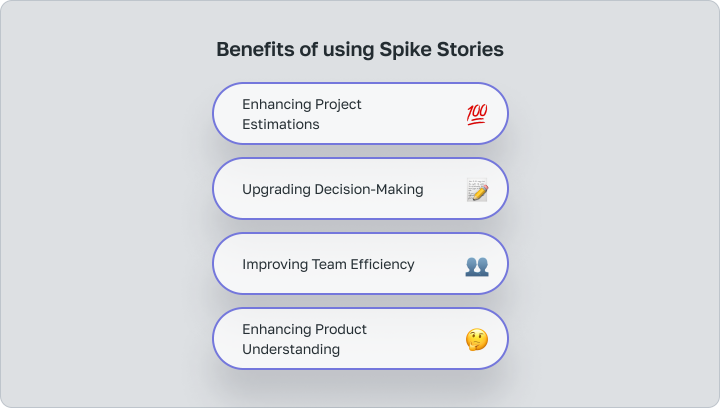
- Reducing Uncertainty: Spike stories allow teams to address uncertainties and unknowns early in the project lifecycle. By investing time in research, experimentation, and exploration, spike in software development provide valuable insights and data that can help teams make more accurate estimations. By gaining a deeper understanding of the problem domain and potential solutions, teams can better assess the effort required to deliver the desired functionality.
- Mitigating Risks: By proactively identifying and addressing risks through spike stories, Agile teams can mitigate potential challenges that may impact project timelines and budgets. Spike stories enable teams to uncover potential roadblocks, dependencies, and technical challenges early on, allowing for proactive risk management and mitigation strategies. This reduces the likelihood of surprises later in the project and enables more realistic estimations of project timelines and resources.
- Informing Decision-Making: Spike stories provide teams with the information and insights needed to make informed decisions throughout the project lifecycle. By conducting research, experimentation, and prototyping, teams can evaluate different approaches, technologies, and solutions before committing to implementation. This enables teams to make informed trade-offs, prioritize effectively, and adapt their plans based on real-world data and evidence gathered through spike story activities.
Improving Team Efficiency and Product Understanding
Spike in Agile project management play a pivotal role in boosting team efficiency and enhancing understanding of the product. Here’s how:
- Focused Exploration: Spike stories provide teams with dedicated time to explore uncertainties, conduct research, and experiment with potential solutions. By allocating specific tasks for investigation, spike stories prevent distractions and ensure that team members can focus their efforts on addressing critical unknowns. This focused exploration enhances team efficiency by streamlining the process of gathering essential information and insights needed to move the project forward.
- Learning Opportunities: Spike in Agile software development create opportunities for continuous learning and skill development within the team. By engaging in research, experimentation, and prototyping, team members have the chance to expand their knowledge, explore new technologies, and enhance their understanding of the product and its underlying technologies. This hands-on experience not only boosts team efficiency by equipping members with new skills and insights but also fosters a culture of innovation and collaboration.
- Improved Decision-Making: Through spike stories, teams gain a deeper understanding of the product and its requirements. By conducting research and experimentation, Agile teams can evaluate different approaches, validate assumptions, and identify potential risks and dependencies. This enhanced understanding enables teams to make more informed decisions about project direction, feature prioritization, and technical implementation. By leveraging the insights gained through spike story activities, teams can make better-informed decisions, leading to more efficient use of resources and improved outcomes for the project.
Challenges and Solutions
Common Challenges in Implementing Spike Stories
Implementing spike in Agile project management can present several challenges. There are some common obstacles and strategies to address them:
- Lack of Clarity: One challenge is the ambiguity surrounding when and how to use spike stories. To address this, establish clear guidelines and criteria for identifying situations that warrant spike stories. Provide training and support to ensure team members understand the purpose and benefits of spike stories.
- Time Management: Allocating the right amount of time for spike stories can be tricky. Teams may struggle to balance the need for thorough exploration with the constraints of sprint deadlines. Mitigate this challenge by carefully estimating the time needed for spike story activities and adjusting sprint planning accordingly. Regularly review and reassess time allocations based on the complexity of the tasks.
- Over-reliance on Spike Stories: There’s a risk of teams relying too heavily on spike stories as a crutch for addressing uncertainties. While spike stories are valuable tools, they should not be used as a substitute for proper backlog grooming and user story refinement. Encourage teams to strike balance between using spike in Agile strategically and ensuring that user stories are sufficiently detailed and actionable.
- Documentation and Communication: Inadequate documentation and communication of spike story findings can hinder their effectiveness. To overcome this challenge, establish a process for documenting and sharing insights from spike story activities. Encourage team members to communicate findings transparently and incorporate them into Agile software development, sprint reviews and retrospectives.
- Resistance to Change: Introducing spike stories may encounter resistance from team members accustomed to traditional Agile practices. Address resistance by emphasizing the benefits of spike in Agile, such as reducing risk, enhancing learning, and improving decision-making. Foster a culture of experimentation and continuous improvement to encourage adoption and acceptance of spike stories as valuable tools in Agile project management.
Strategies to Overcome These Challenges
You could find useful some strategies to effectively tackle the challenges associated with spike stories:
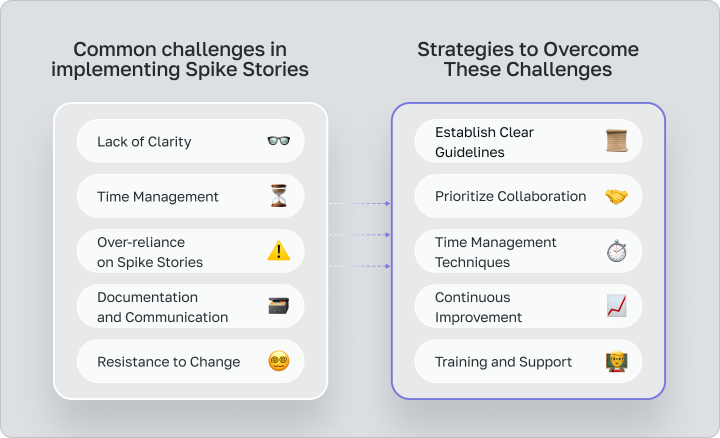
- Establish Clear Guidelines: Provide Agile teams with clear guidelines and criteria for when to use spike stories. Define the purpose, scope, and expected outcomes of spike in Agile activities to ensure consistency and alignment across the team.
- Prioritize Collaboration: Foster collaboration and cross-functional communication within the Agile team. Encourage open dialogue and knowledge sharing to ensure that everyone understands the objectives and findings of spike stories. Facilitate regular meetings and discussions to review progress, share insights, and address any challenges or concerns.
- Time Management Techniques: Use time management techniques such as timeboxing and prioritization to optimize the allocation of time for spike story activities. Break down larger spike stories into smaller, manageable tasks and allocate time accordingly. Set realistic deadlines and milestones to keep the team on track and ensure that spike in Agile are completed stories within the sprint timeframe.
- Continuous Improvement: Encourage a culture of continuous improvement by regularly reflecting on and refining spike story processes. Solicit feedback from team members and stakeholders to identify areas for improvement and implement iterative changes. Celebrate successes and learn from setbacks to continuously enhance the effectiveness of spike in Agile.
- Training and Support: Provide training and support to help team members develop the skills and knowledge needed to effectively utilize spike in Agile. Offer resources, workshops, and mentoring opportunities to build proficiency in research, experimentation, and documentation. Encourage ongoing learning and skill development to empower teams to overcome challenges and maximize the value of spike stories in Agile project management.
Real-World Examples and Case Studies
Success Stories of Implementing Spike Stories
Spike stories have been successfully implemented in various industries, including IT, digital, or architecture. Here are a few examples:
 Software Development Company
Software Development Company
The case: Agile software development company faced a challenge when integrating a new third-party API into their application.
Finding solution: To mitigate risks and uncertainties associated with the integration, they used spike stories to conduct research and experimentation. The team allocated a sprint to explore different integration approaches, test compatibility, and identify potential issues.
The result: They gained valuable insights into the API’s functionality and limitations, allowing them to make informed decisions and streamline the integration process. The project was completed within the planned timeframe, and the integration was successful, thanks to the insights gained through spike story activities.
 Digital Marketing Agency
Digital Marketing Agency
The case: A digital marketing agency embarked on a project to redesign a client’s website to improve user experience and performance. During the planning phase, the agency encountered technical challenges related to the migration of existing content and data.
Finding solution: To address these Agile challenges, they utilized spike stories to investigate potential solutions and assess the feasibility of different migration strategies. By dedicating time to research and experimentation, the team identified the most efficient approach for migrating content while minimizing disruption to the website’s functionality.
The result: The successful implementation of spike in Agile enabled the agency to deliver a seamless website redesign that met the client’s objectives and exceeded expectations.
 Architectural Firm
Architectural Firm
The case: An architectural firm faced a complex design challenge when developing a sustainable building prototype.
Finding solution: To explore innovative design solutions and evaluate the feasibility of incorporating renewable energy technologies, they employed spike in Agile to conduct research and prototyping. The team allocated dedicated time to experiment with alternative materials, energy-efficient systems, and sustainable design practices. Through iterative testing and refinement, they developed a prototype that showcased cutting-edge sustainable design principles and exceeded performance expectations.
The result: The successful implementation of spike in Agile enabled the architectural firm to demonstrate their expertise in sustainable architecture and secure future projects with clients seeking environmentally friendly design solutions.
Lessons Learned and Best Practices from Agile Teams
Some essential lessons and best practices can be learned from Agile teams using spike stories:
- Embrace Uncertainty: Agile teams recognize that uncertainty is inevitable in complex projects. By embracing uncertainty and using spike stories to address unknowns early on, teams can reduce risk and make more informed decisions throughout the project lifecycle.
- Prioritize Learning: Agile teams prioritize continuous learning and improvement. Spike stories provide valuable opportunities for team members to expand their knowledge, explore new technologies, and enhance their skills through hands-on experimentation and research.
- Focus on Collaboration: Collaboration is essential for the success of spike stories. Agile teams foster a culture of collaboration, communication, and knowledge sharing to ensure that everyone is aligned and working towards common goals.
- Iterate and Adapt: Agile teams embrace an iterative approach to development. They use spike stories to gather feedback, iterate on solutions, and adapt their plans based on real-world data and insights. This flexibility allows teams to respond to changing requirements and evolving project needs effectively.
- Document Findings: Documentation is critical for capturing insights and lessons learned from spike story activities. Agile teams document their findings, experiments, and outcomes to ensure that valuable knowledge is shared across the team and can inform future decision-making.
- Stay Focused: Agile teams prioritize focus and discipline when executing spike stories. They avoid getting sidetracked by unrelated tasks or distractions and allocate dedicated time and resources to tackle uncertainties effectively.
- Celebrate Successes: Celebrating successes, no matter how small, is important for morale and team motivation. Teams celebrate the completion of spike in Agile and the insights gained through their efforts, reinforcing a culture of achievement and recognition.
By adopting these lessons and practices, Agile teams can effectively leverage spike stories to manage uncertainty, drive innovation, and deliver successful outcomes in their projects.
Future of Spike Stories in Agile
Emerging Trends and Innovations
As Agile methodologies continue to evolve, several emerging trends and innovations are shaping the future of spike in Agile:
- AI-Powered Spike Stories: The integration of artificial intelligence (AI) and machine learning technologies could revolutionize spike stories by automating research, analysis, and experimentation processes. AI-powered spike stories could leverage data analytics and predictive modeling to identify potential solutions, predict outcomes, and optimize decision-making.
- Virtual Collaboration Tools: With the rise of remote work and virtual collaboration, there’s a growing demand for digital tools that facilitate remote spike story activities. Such project management platforms like Worksection enable teams to conduct research, experimentation, and prototyping collaboratively. Worksection offers a wide range of tools to manage even difficult projects, communicate effectively, find bottlenecks, customize, control, track and analyze tasks.
- Real-time Data Insights: The use of real-time data analytics and monitoring tools enables teams to gather insights and feedback continuously throughout spike story activities. By leveraging real-time data, Agile teams can make informed decisions quickly, identify trends and patterns, and adapt their strategies in response to changing conditions.
- Cross-disciplinary Spike Stories: As projects become increasingly complex and interdisciplinary, there’s a trend towards cross-disciplinary spike stories that involve collaboration between diverse teams and experts from different domains. By bringing together varied perspectives and expertise, cross-disciplinary spike stories enable teams to tackle complex challenges more effectively and drive innovation.
- Predictive Spike Stories: Leveraging historical data, predictive analytics, and machine learning algorithms, predictive spike stories aim to anticipate potential uncertainties, risks, and opportunities before they arise.
Adapting Spike Stories to Changing Agile Environments
Adapting spike in Agile methodologies and environments requires flexibility, innovation, and a willingness to embrace change. Here are some strategies for effectively adapting spike stories to meet the evolving needs of Agile teams:
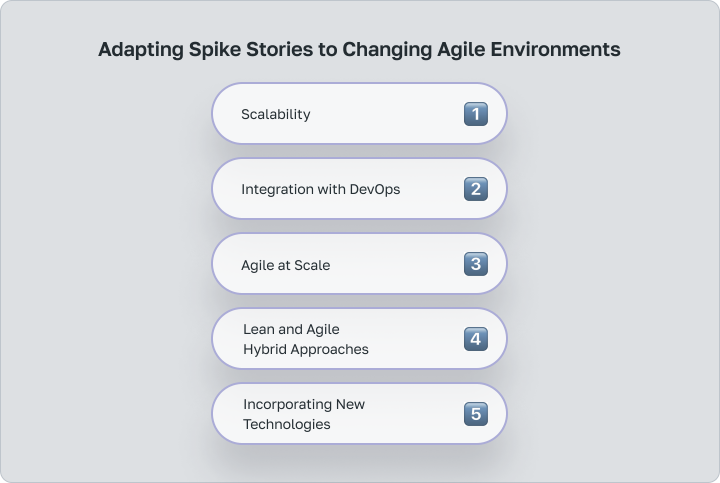
- Scalability: As Agile methodologies evolve to accommodate larger teams and more complex projects, spike stories need to scale accordingly. Teams should adapt their approach to spike stories to ensure that they remain effective and manageable, even as project scope and complexity increase.
- Integration with DevOps: With the growing emphasis on DevOps practices, spike stories can be adapted to align with continuous integration, delivery, and deployment workflows. Teams can use spike stories to explore automation opportunities, evaluate deployment strategies, and optimize DevOps pipelines for efficiency and reliability.
- Agile at Scale: In environments where Agile is scaled across multiple teams or departments, spike stories can serve as a valuable tool for coordinating efforts, managing dependencies, and aligning priorities.
- Lean and Agile Hybrid Approaches: As organizations adopt lean principles alongside Agile methodologies, spike stories can be adapted to support lean experimentation and iterative improvement, to test hypotheses, validate assumptions, and optimize processes in lean and Agile hybrid environments.
- Incorporating New Technologies: With the emergence of new technologies and tools, spike stories can be adapted to explore innovative solutions, evaluate emerging trends, and incorporate cutting-edge technologies into Agile projects.
Conclusion
Summary of Key Insights on Spike Stories
Spike Agile definition is a short, time-boxed task designed for exploration and investigation. It addresses uncertainties, manage risks, and inform decision-making by allowing teams to conduct research, experimentation, and prototyping.
Key insights include the spike’s role in reducing uncertainty, fostering learning, and facilitating collaboration. Effective spike stories are clear, focused, and aligned with project goals, with clear objectives and timeframes. They contribute to better project estimations, informed decision-making, and enhanced team efficiency.
As Agile methodologies evolve, spike stories adapt to meet the changing needs of teams, scaling with project complexity, integrating with DevOps practices, and incorporating new technologies. Ultimately, spike in Agile plays a vital role in driving innovation, managing uncertainty, and delivering successful outcomes in Agile projects.
Final Thoughts on the Role of Spike Stories in Agile Projects
In conclusion, spike in Agile project management is an indispensable tool, serving as beacons of clarity amidst uncertainty. Its role in reducing risks, fostering learning, and informing decision-making is pivotal for project success.
By enabling teams to explore, experiment, and adapt, spike stories empower Agile teams to navigate complex challenges with confidence. They contribute to better estimations, efficient resource allocation, and ultimately, the delivery of value to stakeholders. In the ever-evolving landscape of Agile methodologies, spike stories remain steadfast, guiding teams towards innovation, resilience, and continuous improvement.
